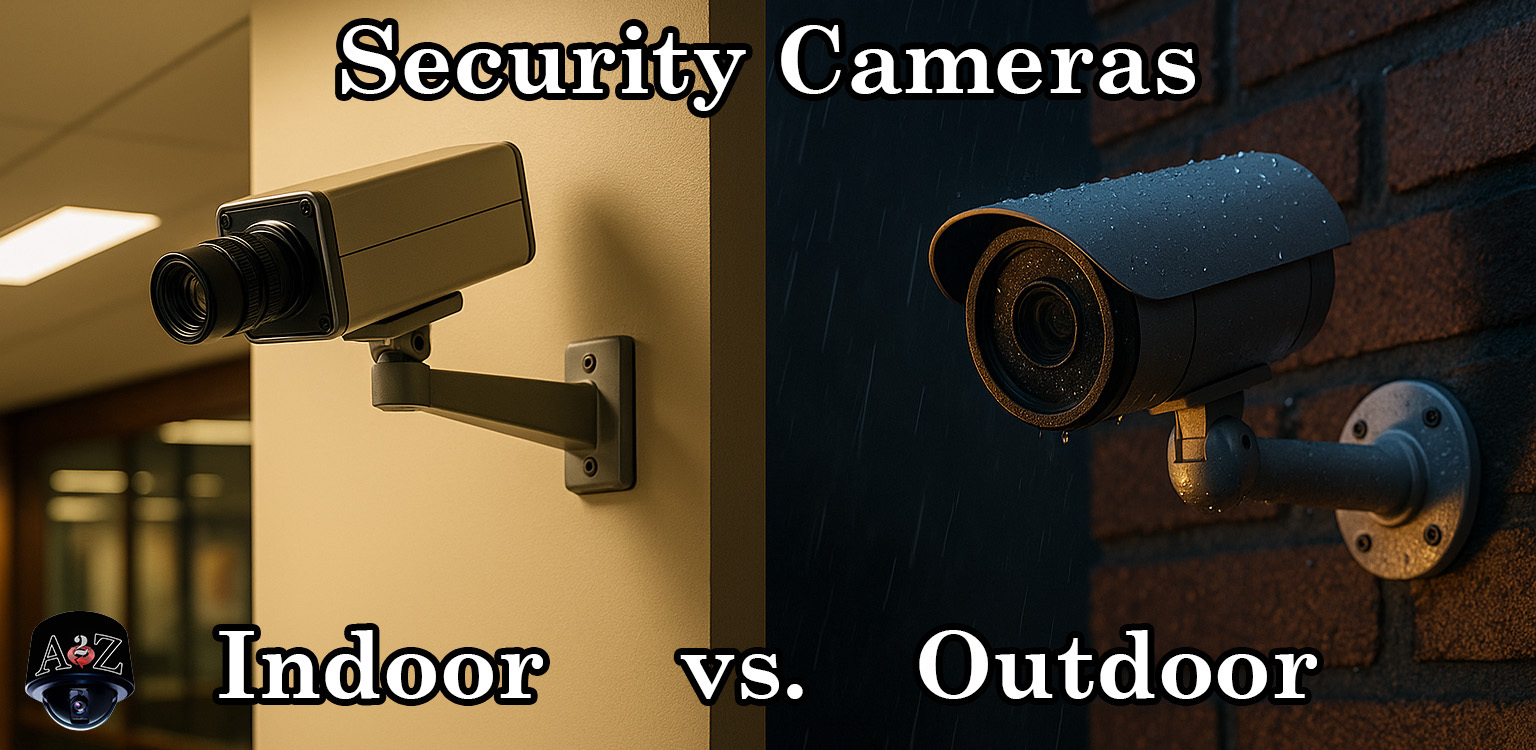Indoor vs Outdoor Security Cameras – Key Differences & Best Uses

By Justin C., Video Security System Specialist — A2Z Security Cameras
Introduction
The line between indoor and outdoor security cameras is not as clear-cut as it may seem.
Many professional manufacturers now produce the majority of their cameras with outdoor weather ratings (IP66 or higher). These rugged designs are often used indoors as well, since their appearance, cost, and performance already meet most project needs.
That said, true indoor-only models still exist — usually designed for cost savings, compact aesthetics, or specialized use cases like panoramic coverage, covert cameras, or custom-lens box-style solutions. Outdoor-rated units, meanwhile, prioritize durability, vandal resistance, and wide operating temperature ranges.
The real question isn’t just “indoor or outdoor,” but rather: Does your site require ruggedness and weatherproofing, or can a lighter-duty indoor model meet your needs more efficiently?
What Defines an Outdoor Camera?
Outdoor-rated cameras are designed to withstand exposure to weather, dust, and in some cases physical tampering as core attributes. Some go further with specialized coatings, added cooling or heating, defogging, de-icing, or even built-in wipers to clear obstructions.
Key Features of Outdoor Models:
- Weatherproofing (IP66/IP67) — protection against rain, dust, and wind.
- Vandal resistance (IK ratings) — durable housings, often domes with metal bases.
- Temperature range — built-in heaters/fans or components rated for extreme heat or cold.
- Flexible mounting options — junction boxes, wall arms, and pole mounts for outdoor deployment.
Examples:
- Bullet cameras on building exteriors
- Dome cameras on parking garage ceilings
- Turret/eyeball cameras on commercial sites
- PTZ cameras mounted on poles or rooftops
What Defines an Indoor Camera?
Indoor models typically omit heavy-duty housings and wide temperature ratings, focusing instead on aesthetics, size, or affordability.
Key Features of Indoor Models:
- Compact, lightweight housings designed for ceiling tiles or discreet placement
- Lower cost due to simpler enclosures
- Often optimized for aesthetics (smaller domes, sleeker turrets)
- Typically lack IP/IK ratings or extreme temperature specs, though some include low-level ratings
Examples:
- Box cameras (outdoor-capable only with a housing)
- Compact dome cameras for offices or retail interiors
- Lower-cost panoramic/multi-sensor cameras in lobbies or conference rooms
- Consumer-grade Wi-Fi cameras for homes
Side-by-Side Comparison
| Feature | Indoor Cameras | Outdoor Cameras |
|---|---|---|
| Durability | Light-duty, no weather sealing | Weatherproof, vandal-resistant housings |
| Temperature Range | Limited, climate-controlled areas | Wide — often -40°C to +60°C |
| Cost | Lower upfront (simpler housings) | Higher due to rugged design |
| Aesthetics | Compact, discreet designs | Larger, bulkier but professional-grade |
| Placement Flexibility | Indoors only | Indoors or outdoors |
| Common Use Cases | Offices, retail interiors, lobbies | Parking lots, building perimeters, schools, public spaces |
Key Considerations
1. Infrastructure & Budget
- If you already plan to buy professional cameras, chances are most options are outdoor-rated by default.
- Choosing indoor-only models may save some cost, but could limit flexibility later if you need to redeploy outdoors.
2. Environmental Conditions
- Outdoor cameras are essential for areas exposed to rain, wind, or dust.
- Indoor models work fine for climate-controlled spaces like offices, stores, and schools.
3. Aesthetic Demands
- Indoor cameras often blend better in hospitality, retail, or office settings where discreet, polished appearances matter.
- Outdoor models are larger and more visible, which can help deterrence but may not suit environments needing unobtrusive surveillance.
4. Security Risk & Vandalism
- Public spaces, schools, and transit hubs benefit from IK-rated domes that resist tampering.
- Indoor-only units are more vulnerable in settings where tampering or vandalism is a concern.
Power & Connectivity Considerations
The way cameras connect to power and networks can vary widely between indoor and outdoor models — and it’s often one of the most overlooked installation details.
Indoor Cameras:
- Typically use simpler cabling or even Wi-Fi in consumer systems.
- Power via standard plugs, 12V adapters, or PoE in professional models.
- Cable terminations don’t need heavy sealing thanks to climate-controlled environments.
Outdoor IP Cameras:
- Generally use PoE or hardwired power.
- Most include a basic weather-seal gland or connector cap, but these parts can be fragile or improperly installed. For long-term reliability, use exterior junction boxes or sealing tape — or select models with integrated junction bases.
- PTZ designs vary: some use gland-style connectors like domes, while others require multi-part assemblies to maintain their waterproof rating.
Outdoor HD-CCTV (Coax) Cameras:
- Less likely to include built-in sealing on BNC/power connectors.
- Exposed coax and power terminations are a weak point outdoors and can quickly corrode.
- For best results, always terminate inside a junction box or seal with professional-grade weatherproofing materials.
Regardless of type, the termination point is usually the weakest link. A camera can have IP67 housing, but if the cabling isn’t properly sealed, water ingress or corrosion can still cause failures.
Ratings & Protection Standards
| Rating | Meaning / Protection Level |
|---|---|
| IP65 | Dust-tight, protected from low-pressure water jets |
| IP66 | Dust-tight, protected from powerful water jets |
| IP67 | Dust-tight, immersion up to 1m temporarily |
| IP68 | Dust-tight, immersion beyond 1m (varies by manufacturer) |
| IP69K | Dust-tight, high-pressure, high-temperature water jets (industrial) |
| IK09 | Vandal protection: resists 10 joules (approx. 5 kg dropped from 20 cm) |
| IK10 | Vandal protection: resists 20 joules (approx. 5 kg dropped from 40 cm) |
These ratings ensure that housings are resistant not only to weather but also to impact and tampering. Always check both IP and IK ratings when evaluating cameras for high-risk or outdoor environments.
Real-World Deployment Examples
Retail Store:
- Indoor domes for aisles and cashier areas, where aesthetics and cost matter.
- Outdoor-rated domes/bullets on entrances, exits, and parking lots for deterrence and durability.
School Campus:
- Outdoor domes and PTZs for parking lots and perimeters.
- Indoor domes for hallways and cafeterias, especially in low-tampering risk zones.
Office Building:
- Compact indoor domes in lobbies, conference rooms, and hallways.
- Outdoor-rated units at entrances, docks, and perimeter zones.
Home / Private Property:
- Indoor Wi-Fi cameras for living areas or nurseries.
- Outdoor-rated bullets or turrets for driveways, backyards, and garages.
Expert Insights
- Most professional cameras are outdoor-rated. It’s often fine — and common — to install them indoors too.
- Indoor-only models are niche. Choose them when aesthetics, compact size, or cost savings are the priority.
- Future flexibility matters. Outdoor models give you the option to redeploy anywhere.
- Don’t put indoor-only cameras outdoors. Lack of sealing leads to premature or immediate failure.
- Vandal resistance is key. Even indoors, high-risk environments like schools or public facilities often use outdoor-rated domes.
- Cable terminations matter. Even the best IP67/IP68 camera will fail if connectors aren’t properly sealed or protected.
Conclusion
The distinction between indoor and outdoor cameras is less about two separate categories, and more about matching durability and design to environment.
- Outdoor-rated cameras dominate the professional market, offering weatherproofing, vandal resistance, and flexibility for both indoor and outdoor use.
- Indoor-only cameras still have a place — particularly where aesthetics, compactness, or budget drive the decision.
Ultimately, the right choice depends on your site conditions, risk level, and long-term needs. For most projects, outdoor-rated models provide the best flexibility and protection, while indoor-only units remain useful for specialized applications.
Next Steps
- Read: Wired vs. Wireless Security Cameras – Which is Better?
- Read: Choosing the Right Resolution – 1080p, 4MP, 4K, and Beyond
- Browse All Security Cameras
- Browse our CCTV Cameras and IP Cameras
- Contact our design team to discuss the right mix for your project.
